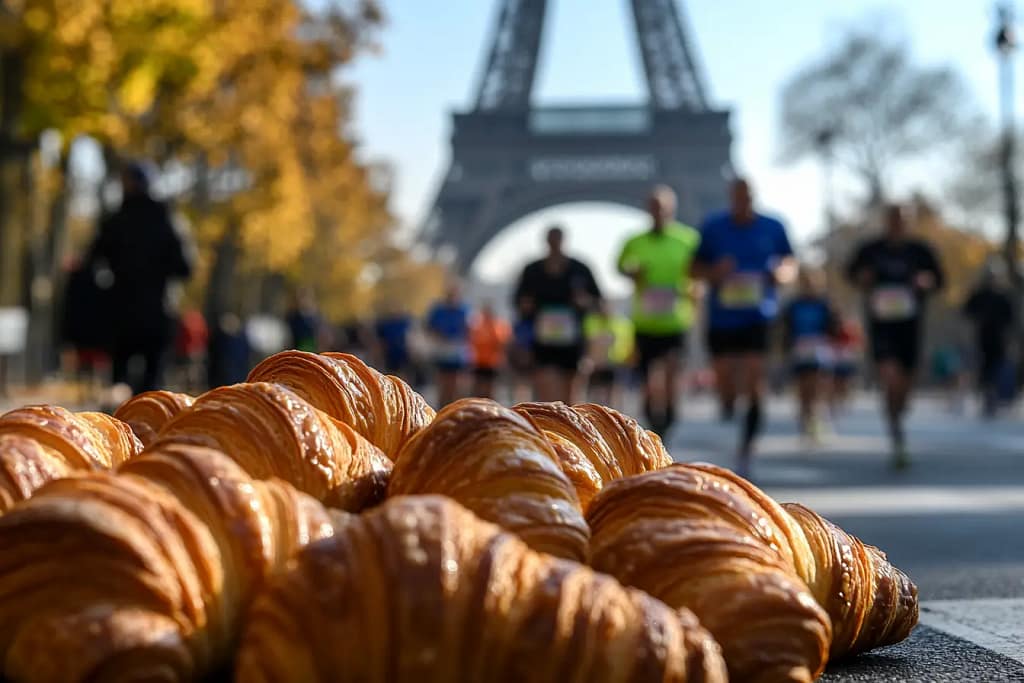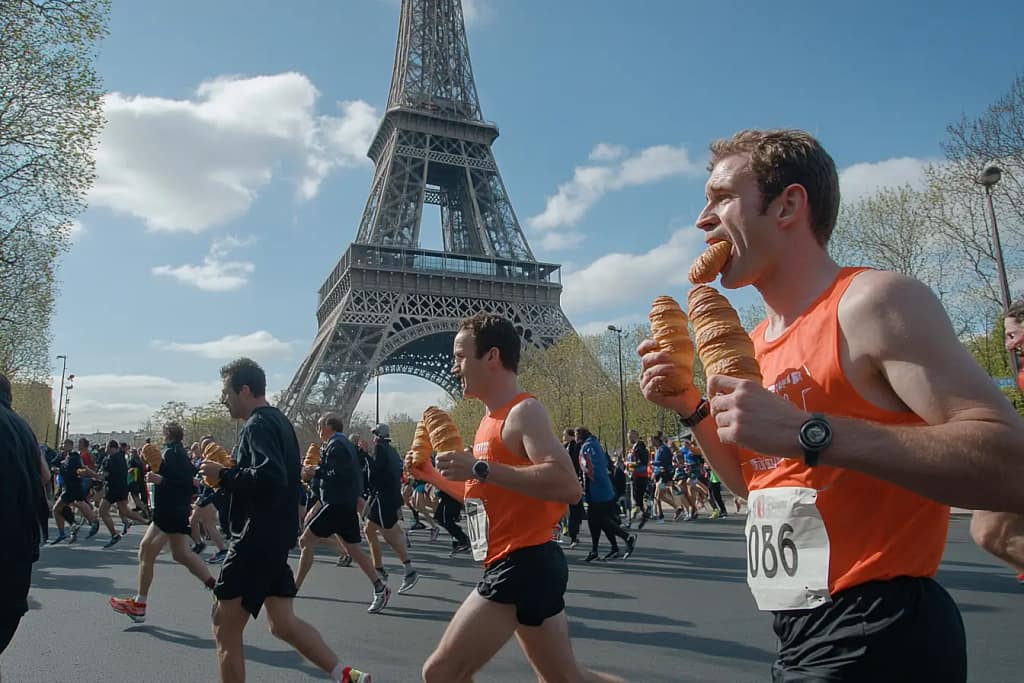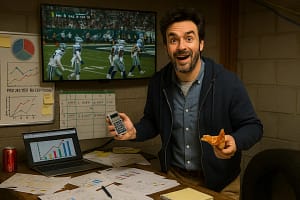Olympic Marathon Rerouted Due to Runners Stopping for Croissants

In a historic first, the Olympic Marathon opened its doors to the general public this year, allowing non-athletes to compete alongside the world’s elite runners. What was meant to be an inclusive and exhilarating event took a hilariously unexpected turn when the route had to be rerouted due to an overwhelming number of runners stopping for croissants.
The Great Democratic Marathon Experiment
The International Olympic Committee (IOC), in an unprecedented move aimed at promoting inclusivity and public engagement, announced last year that the 2024 Olympic Marathon would be open to anyone willing to lace up their sneakers. The decision was met with widespread enthusiasm, with thousands of hopefuls from around the world descending upon Paris for the chance to run in the footsteps of legends.
Pierre LeCroissant, the IOC spokesperson, proclaimed, “The Olympic spirit is about unity and perseverance. What better way to embody this than by allowing everyone to participate in the marathon? We are thrilled to see such a diverse array of participants.”
A Marathon Like No Other
On the morning of the marathon, the streets of Paris were alive with excitement. Professional athletes warmed up alongside eager amateurs, each sharing in the camaraderie that the Olympic spirit inspires. Among the masses were families, groups of friends, and even costumed runners—one memorable participant dressed as a giant baguette.
As the starting gun fired, the race began with a burst of energy and enthusiasm. However, what was supposed to be a seamless integration of professional and amateur runners quickly turned into a comical display of human nature.
The Allure of Parisian Pastries
Paris, famed for its culinary delights, presented an irresistible temptation for the non-professional runners. As the route meandered through the picturesque streets, participants found themselves passing by an array of charming boulangeries, each emitting the tantalizing aroma of freshly baked croissants.
Within the first kilometer, a trickle of runners began to slow down, their gazes fixed on the inviting pastry displays. By the second kilometer, the trickle had become a steady stream. By the third, it was a full-blown phenomenon.
Jean-Luc Petit, owner of “La Belle Boulangerie” on Rue de Rivoli, recounted the surreal scene: “I thought it was a joke at first. But then, one after another, they came in, asking for croissants. It was like the marathon had turned into a brunch run!”
Chaos and Comedy
As the ranks of croissant-craving runners swelled, the marathon route became a labyrinth of people juggling pastries and trying to navigate the cobblestone streets. Elite runners, accustomed to maintaining a blistering pace, found themselves dodging clusters of tourists posing for selfies with their newfound croissant companions.
Olympic marathoner and gold medal favorite, Eliud Kipchoge, expressed his bewilderment: “I’ve trained for years, but nothing prepared me for this. One moment I was in the lead, the next I was stuck behind a family of five debating the merits of almond versus chocolate croissants.”
The situation escalated further when entire groups of tourists decided to transform the marathon into an impromptu sightseeing tour. They wandered off course to snap photos of landmarks, share bites of their pastries, and even engage in leisurely picnics. The Seine’s scenic banks became littered with runners sprawled on blankets, enjoying the unexpected marathon feast.

A New Route Emerges
With the marathon route in disarray, the organizers faced a logistical nightmare. Spectators and officials watched in amusement as the traditional race quickly devolved into a series of detours and diversions. The only solution was to reroute the marathon entirely.
Pierre LeCroissant announced the changes with a mix of frustration and humor: “We did not foresee the irresistible draw of Parisian pastries. To ensure the integrity of the race, we are implementing a new route that avoids boulangeries and patisseries.”
The revised route, hastily mapped out, took runners through a more commercial and less gastronomically enticing part of the city. Participants were redirected past office buildings, construction sites, and a conspicuously high number of fitness centers, presumably to deter any further indulgences.
The Spirit of the Marathon
Despite the chaos, the marathon’s spirit remained unbroken. Many runners embraced the absurdity of the situation, sharing laughs and croissants as they navigated the new course. Some professional athletes, initially frustrated, joined in the merriment, recognizing the unique nature of this historic race.
Amateur runner Sophie Dubois captured the sentiment perfectly: “I may not have finished the marathon in record time, but I experienced Paris in a way I never imagined. It’s the most fun I’ve ever had running—or eating!”
Post-Marathon Reflections
In the aftermath of the event, the IOC and Parisian officials were left to ponder the lessons learned from the Great Democratic Marathon Experiment. While the race did not go as planned, it undeniably brought people together in unexpected and delightful ways.
Paris Mayor Anne Hidalgo commented, “This marathon reminded us of the joy and spontaneity that makes our city unique. While we may need to reconsider our approach for future events, we celebrate the spirit of those who participated.”
Pierre LeCroissant added, “We aimed to unite the world through running, and in a way, we succeeded. Next time, perhaps we will include a croissant-eating contest as an official event.”
The Future of Inclusive Marathons
The 2024 Olympic Marathon will be remembered not for its records or athletic feats but for its heartwarming and hilarious moments. It served as a reminder that the essence of the Olympics lies not just in competition but in the shared human experience.
As the IOC looks ahead to future Games, the lessons from Paris will undoubtedly shape their approach to inclusivity and public participation. The possibility of more open events looms, though with perhaps a bit more foresight regarding potential culinary distractions.
For now, the streets of Paris have returned to their usual rhythm, the boulangeries restocked, and the marathon participants have gone home, carrying with them stories of a race like no other. The Olympic Marathon of 2024 will be etched in history as the race where running met indulgence, and everyone, in their own way, emerged victorious.
The Final Croissant
In the end, the Olympic Marathon’s experiment with inclusivity offered a delightful twist to the traditional race. It highlighted the joys of serendipity and the irresistible allure of Parisian culture. While future marathons may return to more conventional formats, the 2024 edition will forever stand as a testament to the unpredictability and charm of bringing the world together, one croissant at a time.
So, if you find yourself in Paris, remember the marathon’s lesson: life is a journey best enjoyed with a croissant in hand and a smile on your face. And who knows? Maybe one day, you’ll join a race where the finish line is less about speed and more about savoring every delicious moment along the way.



